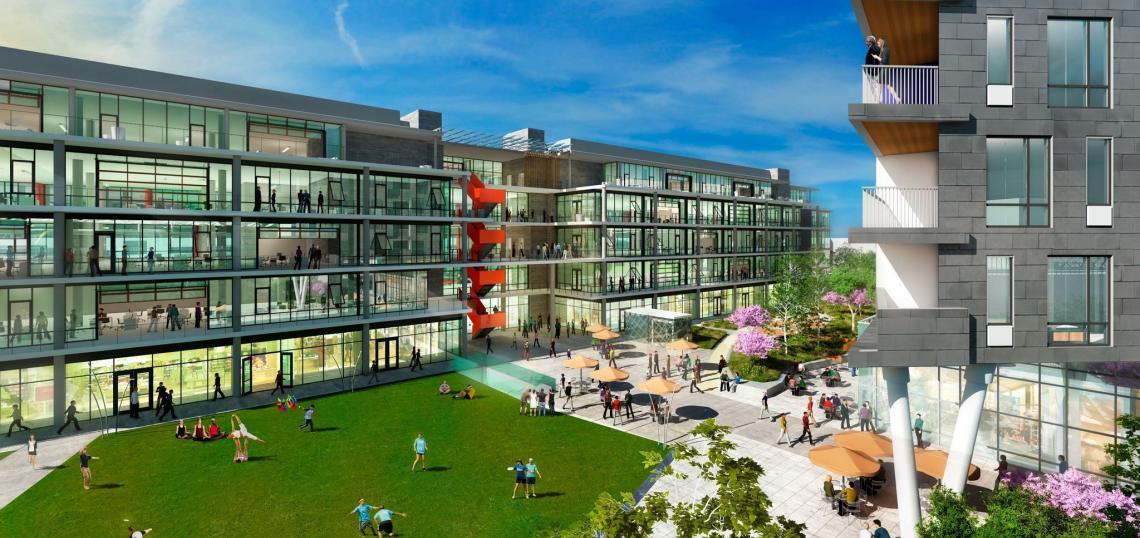The Culver City TOD Visioning Study took a step forward last month with a presentation of preliminary recommendations to the Culver City Council. The study, a six-month effort led by Johnson Fain, examines mobility and circulation surrounding the Expo Line, as well as potential linkages between Downtown Culver City and surrounding communities.
According to urban designer David Alpaugh with Johnson Fain, the goal of the study is to increase the viability of alternate transportation modes for residents and visitors to Culver City. It looks to establish the already-existing TOD zone as a pedestrian-first environment, with provisions for first/last mile connections, cycling and a diversion of traffic flow away from abutting residential neighborhoods.
Recommendations from the study include:
Servicing the downtown/commercial core and the eastside employment centers from the perimeter, protecting interior neighborhood circulation from cut-through traffic.
Alpaugh notes that at the east end of Culver City, residential neighborhoods are surrounded by major employment centers such as the Hayden Tract, which draws substantial cut-through traffic. A potential mitigation measure could be shared parking garages on the perimeter of these employment centers, with shuttle service to office sites.
Redesigning street intersections in the district for pedestrian priority with more frequent and improved crosswalks and implementing neighborhood protection interventions focused on the safety of pedestrians.
Similar improvements have been implemented in Los Angeles through the Vision Zero program, including restriped crossings and bollards. Traffic calming mechanisms have also been recommended for internal residential streets and some more heavily-trafficked thoroughfares.
Establishing a system of flexible, on-demand micro-transit for area residents and employees and facilitating the efficiency of transit and micro-transit through dedicated street lanes and strategic connections
This concept would consist of six-to-eight-passenger vehicles that could provide on-demand services, similar to an Uber Pool. At a future date, these could be autonomous vehicles that operate within a geofenced area, centered on the Expo Line and employment centers. They could be operated by Culver City or a corporate entity.
Improving the Washington/Culver corridor as the city’s major local east/west bike spine and developing a network of bike lanes, paths, and sharrows to connect local and regional systems with additional connections to the Ballona Creek Bike Path.
Planning is already underway for protected bike lanes connecting Downtown Culver City to the Expo Line via Washington Boulevard. Further bicycle infrastructure could build provide similar treatments to other parts of Washington and Culver Boulevard. Portions of Culver already feature a median bike path on a repurposed railroad right-of-way.
Working toward a peripheral shared parking plan with congestion pricing, connected with the proposed micro-transit system.
Peripheral parking could alleviate cut-through traffic through residential neighborhoods, and work in concert with on-demand shuttles.
Planning for more substantial infrastructure improvements including additional crossings of Ballona Creek for vehicular access to east side employment centers and coordinating with other jurisdictions toward an improved through-traffic bypass solution.
The presence of Ballona Creek funnels all automobile traffic through the Hayden Tract onto Higuera Street, National Boulevard and Duquesne Avenue. Additional crossings would alleviate the rush-hour traffic crush that frequently overflows into adjacent residential neighborhoods. However, creating new bridges across the creek would require some acquisition of private property.
Implementing over time a ‘complete streets” design for Washington Blvd., placing priority on enhancing the convenience and safety of the pedestrian experience, facilitating use of the street by transit and other high-occupancy vehicle circulation, and providing a safe and connected place for cyclists.
This would involve the segment of Washington Boulevard running east from the Expo Line to the Culver City - Los Angeles border. The area, considered the Culver City Arts District, features a long stretch of commercial buildings flanked by residential neighborhoods. A complete streets makeover for Washington would calm traffic through the area, and create better pedestrian connections to the Downtown area. While there is some potential for redevelopment along this stretch, the narrow lot sizes will likely prohibit larger mixed-use construction, according to Alpaugh.
Expanding the existing TOD district boundaries and adopting a TOD ordinance including urban design guidelines, re-defined parking requirements, and encouragement of affordable housing.
The study recommends expanding the current TOD district west across Robertson Boulevard to include the block which stands between the Expo Line Station and Downtown Culver City. This effort would echo a similar plan from the City of Los Angeles, which is looking to rezone properties north across Venice Boulevard as part of the Expo Transit Corridor Neighborhood Plan.
Enacting a Transportation Demand Management (TDM) ordinance and establishing a Transportation Management Association / Organization (TMA/TMO) to manage a Mobility Fund, develop an education and outreach program, and introduce “smart” way finding and information systems
Similar policies are already in place in neighboring jurisdictions.
The recommendations were presented informally to the Culver City Council in August for initial comment and review. A final report and recommendations are anticipated to be submitted to Council in October.
- Culver City Envisions a Transit Oriented Future (Urbanize LA)






